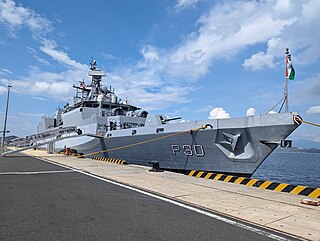
INS Delhi is the lead ship of her class of guided-missile destroyers of the Indian Navy. She was built at the Mazagon Dock Limited in Mumbai and commissioned on 15 November 1997. This class is among the largest warships to be designed and built in India.

The Rajput-class guided-missile destroyers built for the Indian Navy are modified versions of Soviet Kashin-class destroyers. They are also known as Kashin-II class. The ships were built in the former Soviet Union after considerable Indian design modifications to the Kashin design. These included the replacement of the helicopter pad in the original design with a flight elevator, as well as major changes to the electronics and combat systems. Five units were built for export to India in the 1980s. All units are currently attached to the Eastern Naval Command.

INS Rana is a Rajput-class destroyer in active service with the Indian Navy. She was commissioned on 28 June 1982.

INS Ranvijay is a Rajput-class destroyer in active service with the Indian Navy. Ranvijay was commissioned on 21 December 1987.

The Shivalik class or Project 17 class is a class of multi-role frigates in service with the Indian Navy. They are the first warships designed with low observability features built in India. They were designed to have better stealth features and land-attack capabilities than the preceding Talwar-class frigates. A total of three ships were built between 2000 and 2010, and all three were in commission by 2012.

Kora-class corvettes, also known as Project 25A, are guided missile corvettes, in active service with the Indian Navy and the National Coast Guard of Mauritius. Four vessels were built at Garden Reach Shipbuilders and Engineers (GRSE) and outfitted at Mazagon Dock Limited (MDL).

INS Shivalik (F47) is the lead ship of her class of stealth multi-role frigates built for the Indian Navy. She is the first stealth warship built by India. She was built at the Mazagon Dock Limited (MDL) located in Mumbai. Construction of the vessel began in 2001 and was completed by 2009. She underwent sea trials from thereon before being commissioned on 29 April 2010.

The Andaman and Nicobar Command (ANC) is a integrated tri-services command of the Indian Armed Forces, based at Port Blair in the Andaman and Nicobar Islands, a Union Territory of India. It was created in 2001 to safeguard India's strategic interests in Southeast Asia and the Strait of Malacca by increasing rapid deployment of military assets in the region. It provides logistical and administrative support to naval ships which are sent on deployment to East Asia and the Pacific Ocean.

INS Kora is the lead ship of the Kora-Class of 1,350-tonne guided missile Corvettes in active service with the Indian Navy. The vessel was built at Garden Reach Shipbuilders and Engineers (GRSE) and outfitted at Mazagon Dock Limited (MDL).

INS Kuthar (P46) is a Khukri-class corvette, currently in service with the Indian Navy. It was designed by Indian naval architects and built at the Mazagon Dock in Mumbai. INS Kuthar was part of Western Naval Command till 1998 later it moved to be part of Eastern Naval Command. It was damaged in a mishap that occurred on 15 July 2014. The mishap occurred after the naval ship returned to its base in the Andaman and Nicobar Command in rough weather after completing a mission.

INS Kirch is a Kora-class corvette, currently in active service with the Indian Navy.

INS Karmuk is a Kora-class corvette, currently in active service with the Indian Navy.

INS Satpura (F48) is a Shivalik-class stealth multi-role frigate built for the Indian Navy. This class is an improvement over the preceding Talwar-class frigates with increased stealth and land attack features.

INS Kamorta is the first of four anti-submarine Kamorta-class stealth corvettes which has been built for the Indian Navy.

INS Shakti (A57) is a Deepak-class fleet tanker in service with the Indian Navy. She was built by Fincantieri, an Italian shipbuilding company based in Trieste. She is the second and final ship of her class. Shakti, along with her predecessor Deepak, is one of the largest ships of the Indian Navy.

INS Jyoti (A58) is the third of four Komandarm Fedko-class replenishment oilers. She was modified for naval use and is now being operated by the Eastern Naval Command of the Indian Navy. Jyoti was the largest ship in the navy until INS Vikramaditya (R33) was commissioned in November 2013. It is the third largest ship in the Indian Navy after the aircraft carriers INS Vikrant and INS Vikramaditya. Its primary role is fleet replenishment and sustaining blue-water operations. It was later fitted with close-in weapon systems for self-defence.

INS Kiltan (P30) is an anti-submarine warfare corvette of the Indian Navy built under Project 28. It is the third of four Kamorta-class corvettes. The ship was built by the Garden Reach Shipbuilders and Engineers (GRSE), Kolkata, launched on 26 March 2013, and commissioned on 16 October 2017. Kiltan represents a leap forward in the Navy's attempts at localisation with as much as 90% of its content drawn from India itself.

Singapore India Maritime Bilateral Exercise (SIMBEX) is an annual bilateral naval exercise conducted by the Indian Navy and the Republic of Singapore Navy (RSN) previously known as Exercise Lion King.

Theatre Level Operational Readiness Exercise (TROPEX) is an inter-service military exercise involving the participation of the Indian Army, Air Force, Navy and the Coast Guard. The exercise generally commences at the beginning of each year and lasts a month. It is generally carried out in three phrases: independent workup phase, joint workup phase and tactical phase.

Vice Admiral Gurcharan Singh, AVSM, NM is a serving Flag officer in the Indian Navy. He assumed the appointment of Commandant, National Defence Academy on 25 May 2024 from Vice Admiral Ajay Kochhar. He earlier served as the Controller Personnel Services and as the Flag Officer Commanding Eastern Fleet.


























